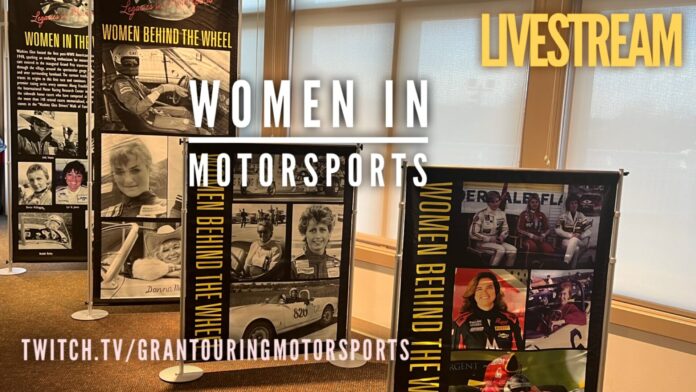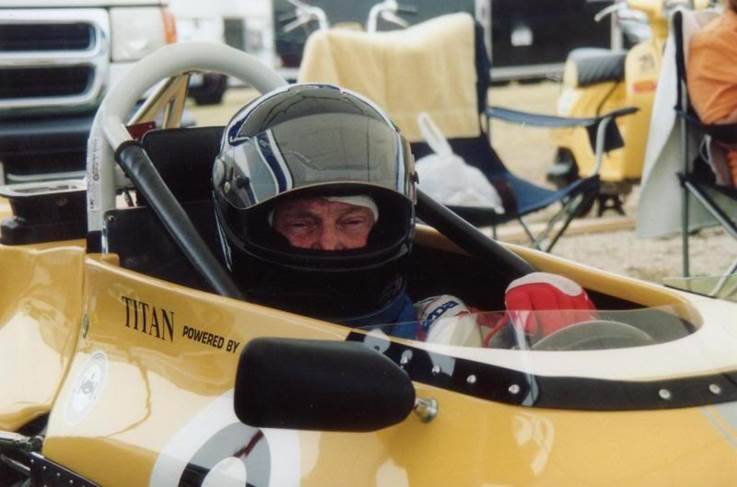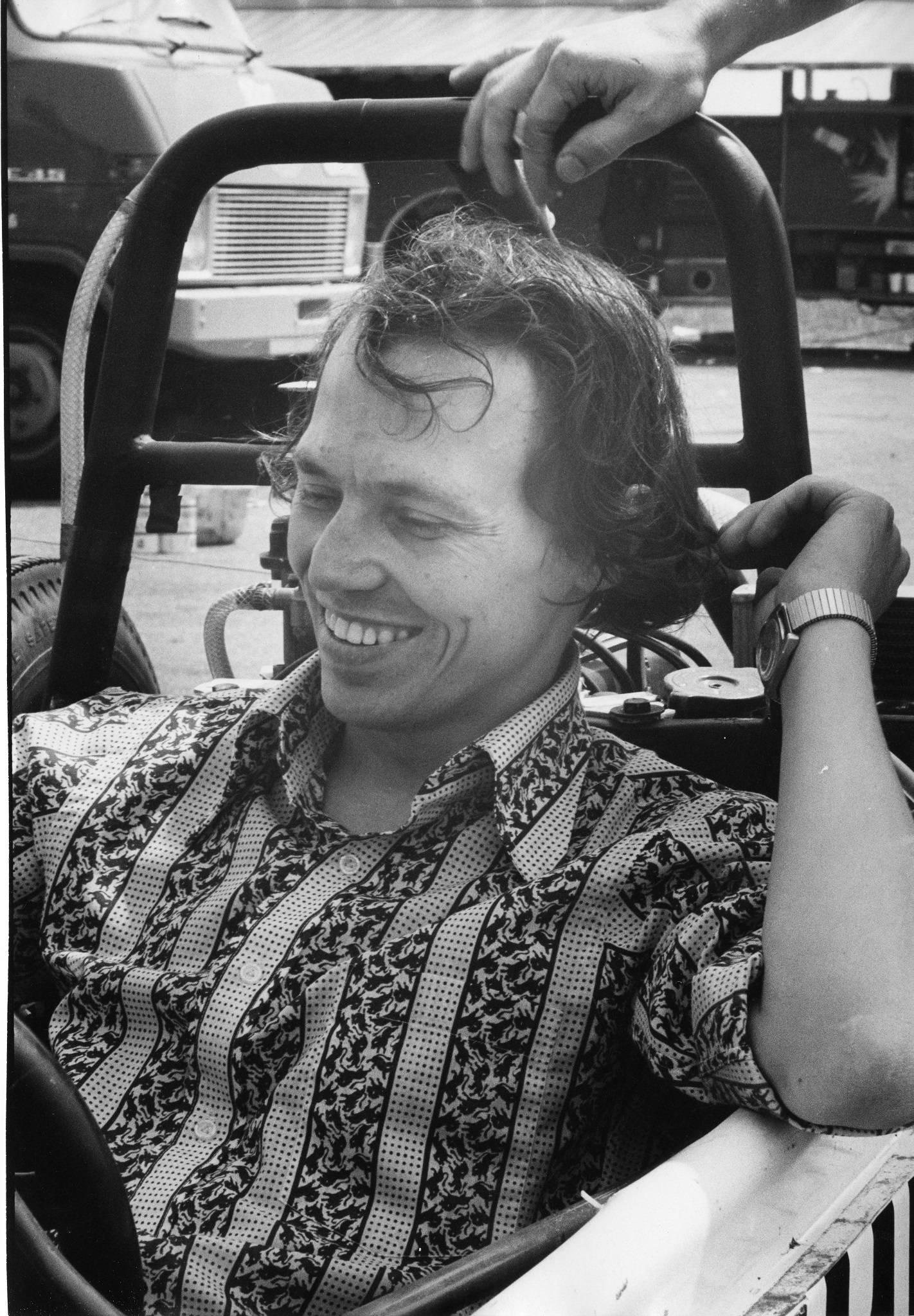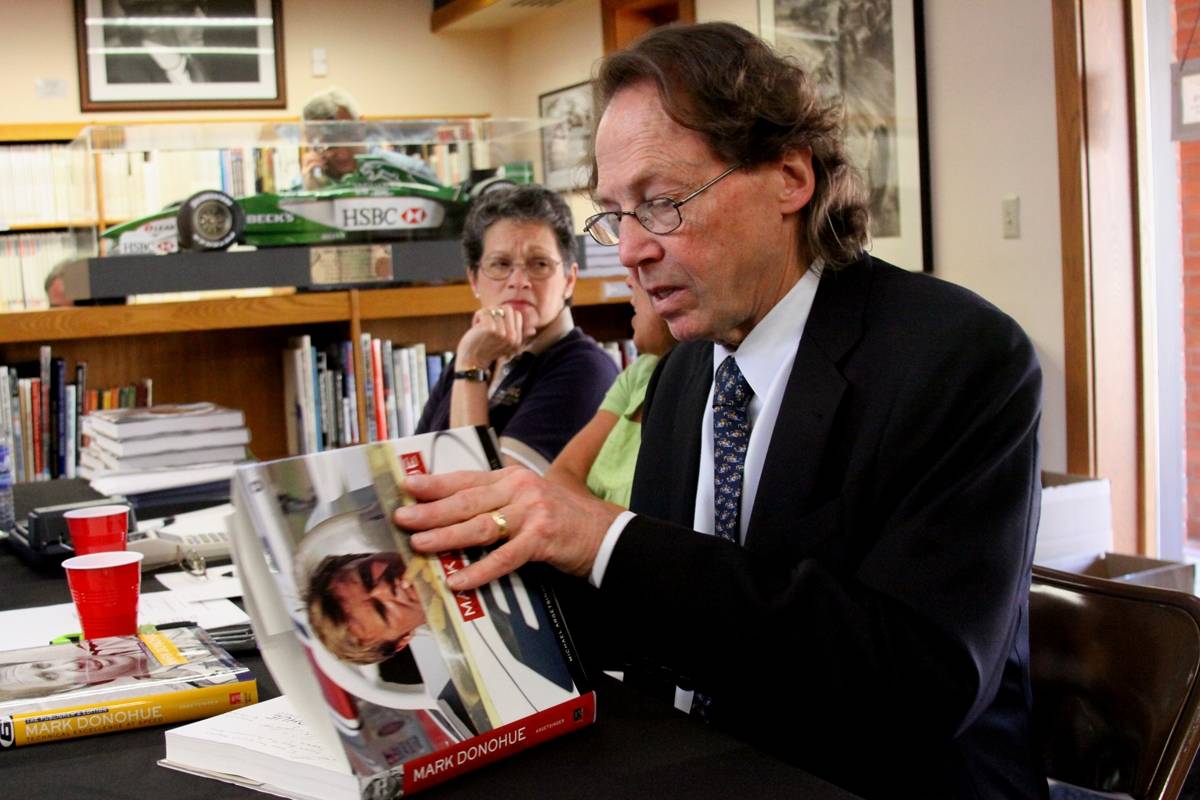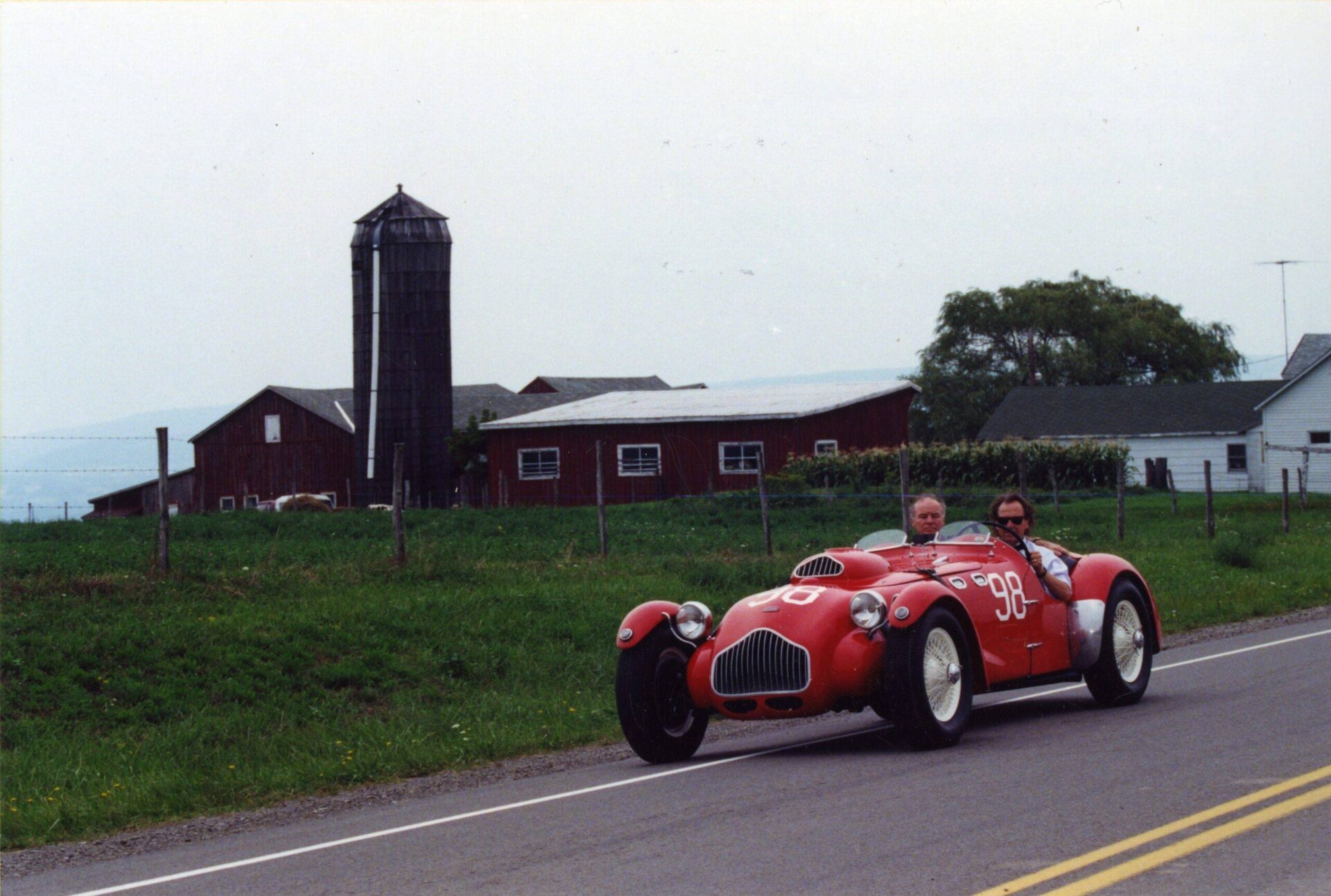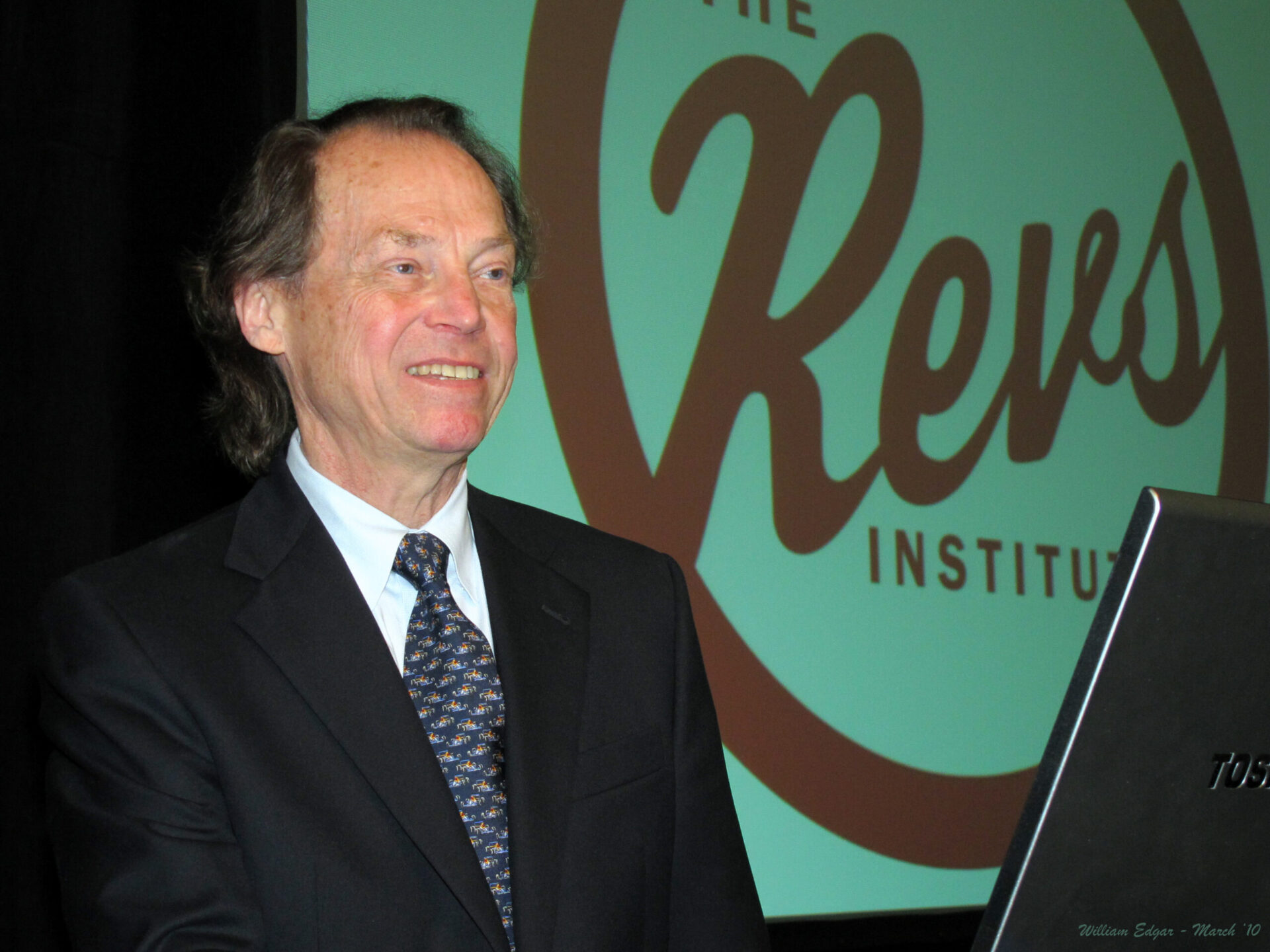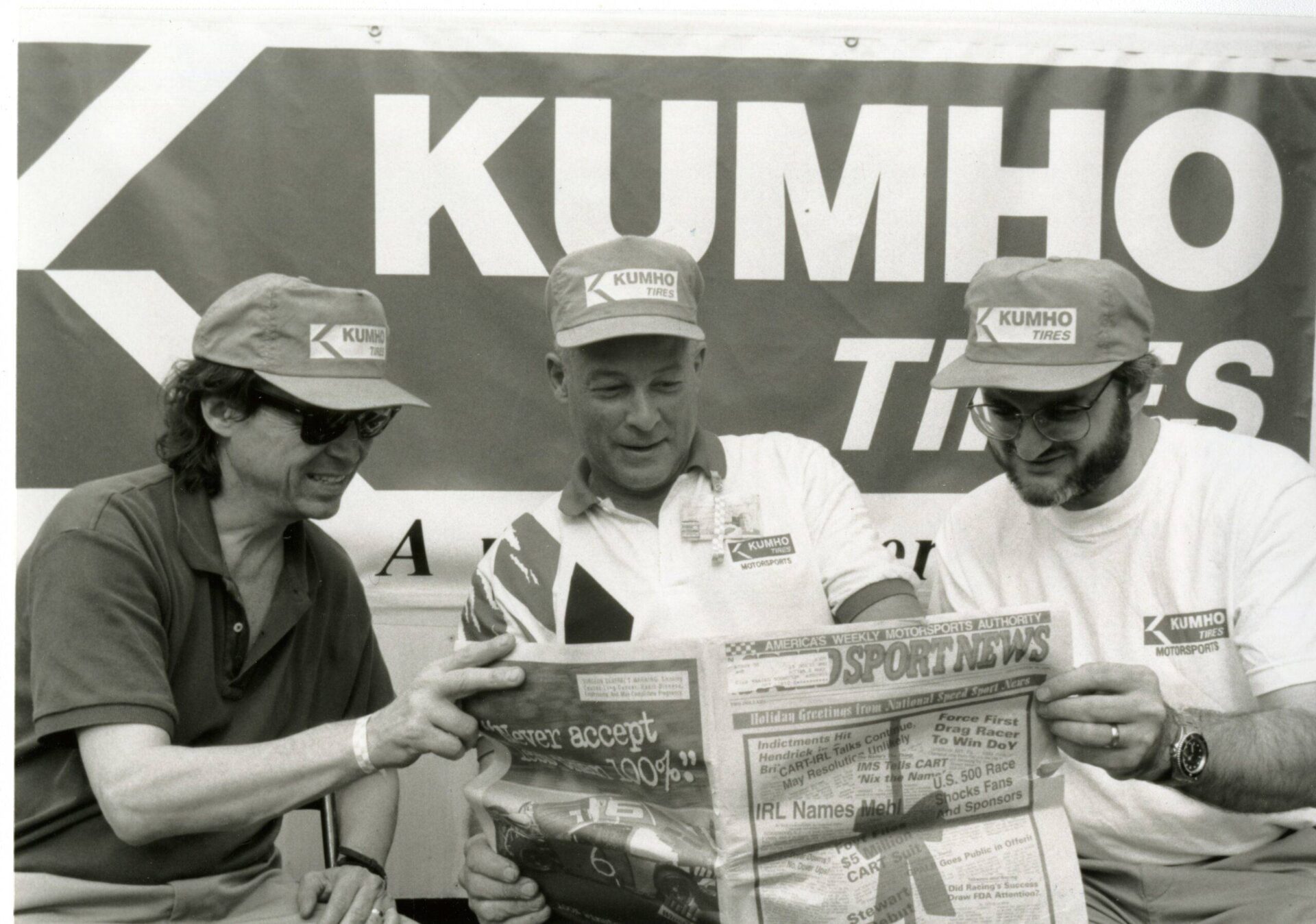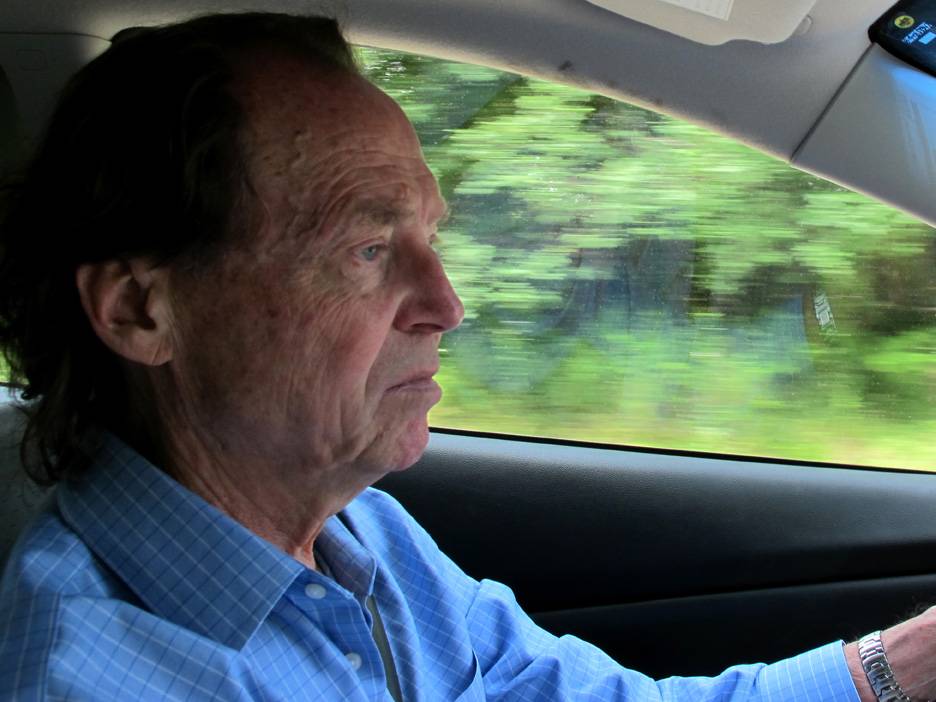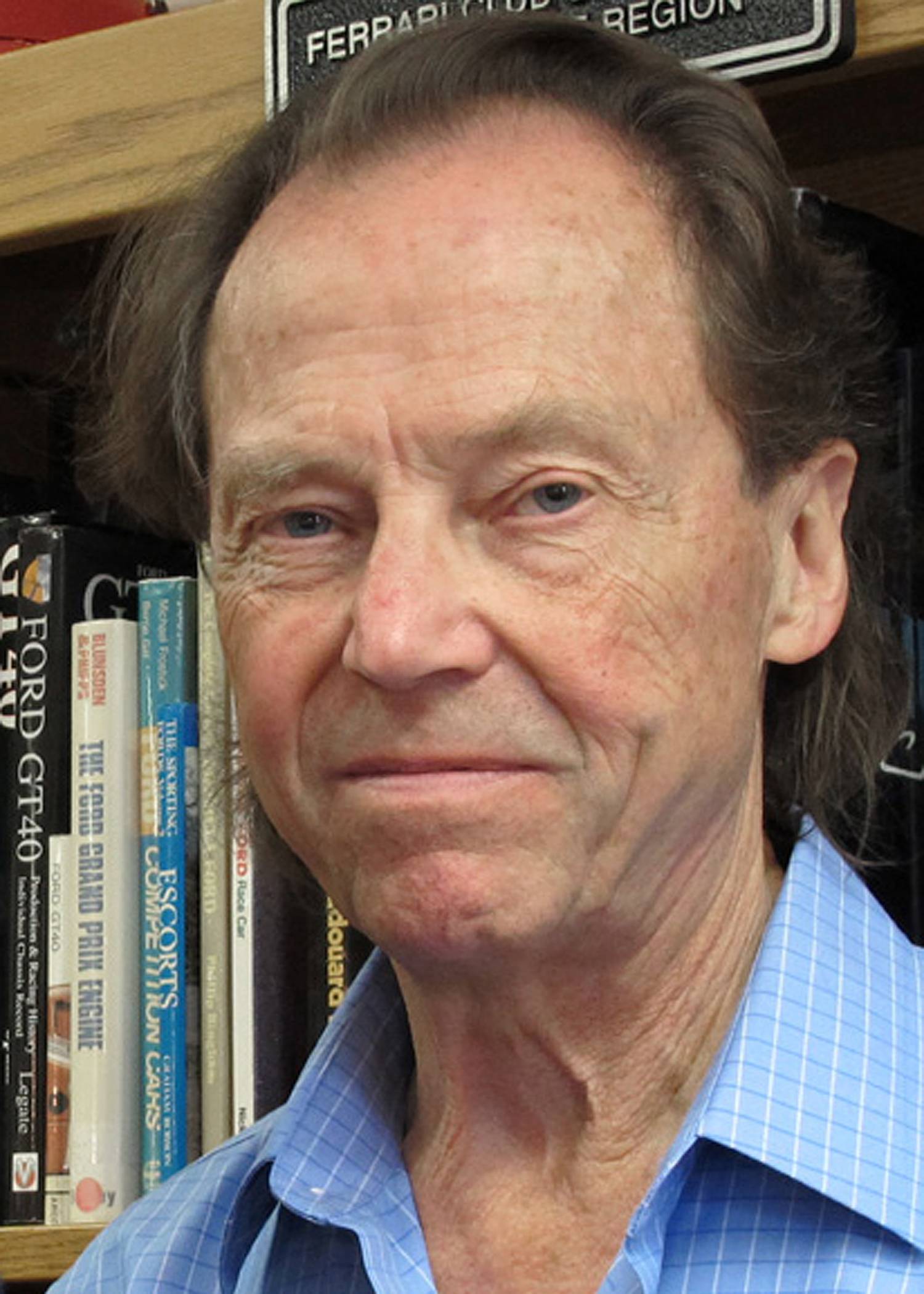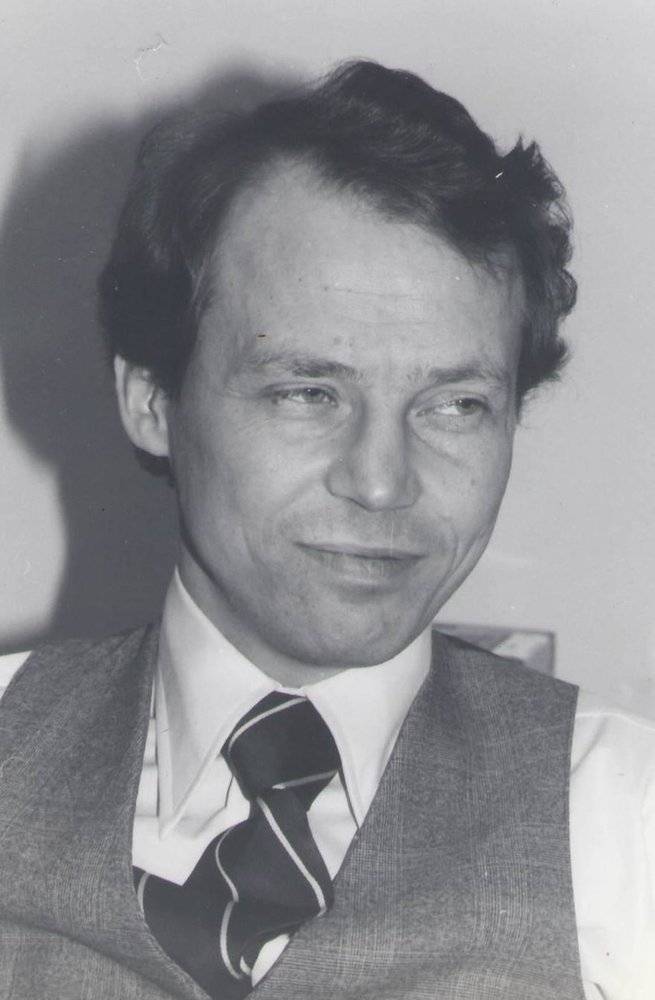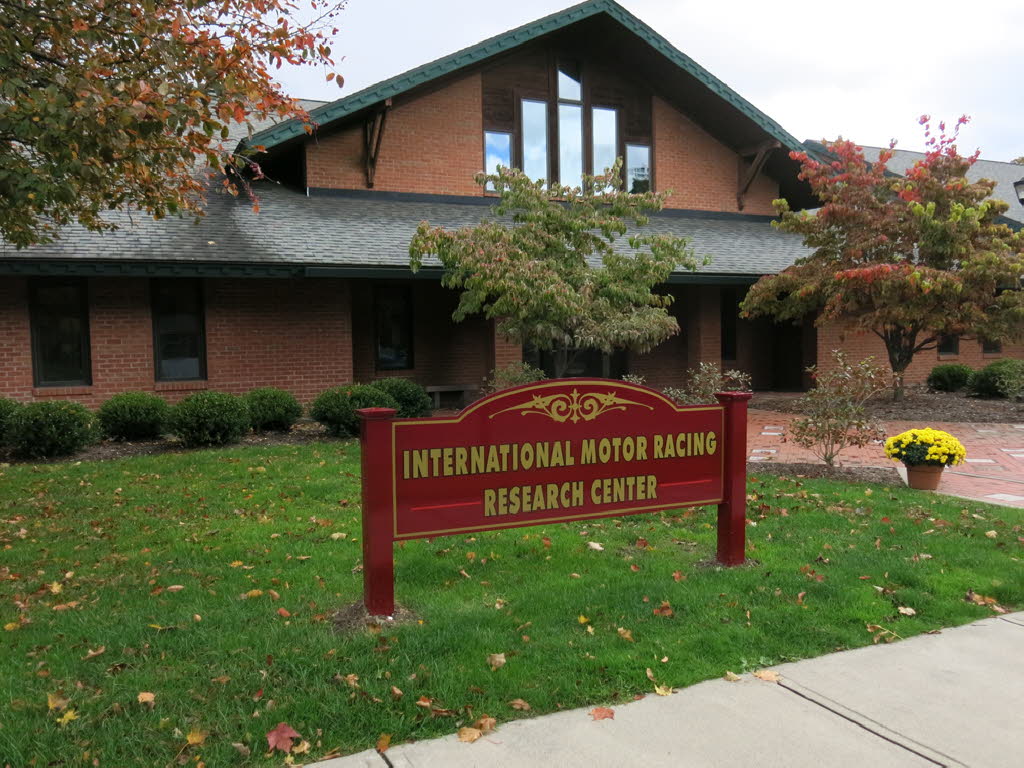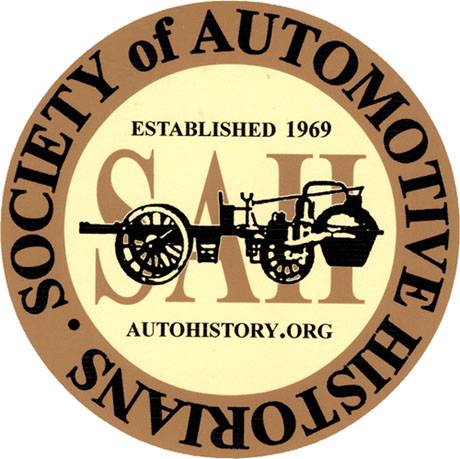The Symposium has provided a platform for excellent in-depth and thought-provoking presentations on the successes, struggles, and contributions of unheralded women racers and car owners across various auto racing disciplines. The green flag for this roundtable discussion will wave with panelists (Lauren Goodman, Buz McKim and Chris Lezotte) integrating these prior presentations into a brief historiographical discussion of women in motorsport. From there, the panelists will pull from their multi-disciplinary backgrounds and markedly different professional experiences and discuss why, where, and how they extended the boundaries of women in motorsports history scholarship. Finally, the audience will take the checkered flag with a challenge: to propose new themes and topics for future conversations, with an emphasis on the accomplishments women have made in motorsports without ever owning or taking the wheel behind race car.
Bio
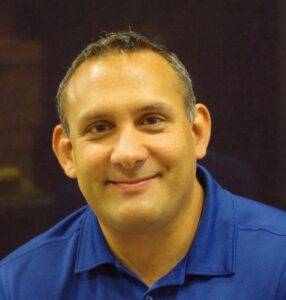
Daniel J. Simone (Moderator for this Roundtable) earned his Ph.D. in History from this University of Florida. He then taught at Monmouth University before serving as curator at the NASCAR Hall of Fame from 2016-2021. Dr. Simone is on the Indianapolis Motor Speedway Hall of Fame Voting Committee and delivers presentations and academic papers at universities and automotive museums across the United States and Canada. He currently serves as program assistant at the New York Historical Society Museum & Library, where he is co-processing and researching the Women’s Sports Foundation Collection and conducting oral histories and developing content for a digital exhibition.
Transcript
[00:00:00] Brake Fix’s History of Motorsports series is brought to you in part by the International Motor Racing Research Center, as well as the Society of Automotive Historians, the Watkins Glen Area Chamber of Commerce, and the Argettsinger family. 50 years after Title IX. On and Off the Track, a roundtable on women in motorsports, moderated by Daniel J.
Simone. Daniel J. Simone earned his PhD in history from the University of Florida. He then taught at Monmouth University before serving as curator at the NASCAR Hall of Fame from 2016 to 2021. Dr. Simone is on the Indianapolis Motor Speedway Hall of Fame voting committee and delivers presentations and academic papers at universities and automotive museums across the United States and Canada.
He currently serves as program assistant at the New York Historical Society Museum and Library, where he is co processing and researching the Women’s Sports Foundation Collection and conducting oral histories and developing content for digital exhibition. The symposium has provided a [00:01:00] platform for excellent in depth and thought provoking presentations on the successes, struggles, and contributions of unherald women racers and car owners across various auto racing disciplines.
The green flag for this roundtable discussion will wave with the panelists integrating these prior presentations. into a brief discussion of women in motorsports. From there, the panelists will pull from their multidisciplinary backgrounds and markedly different professional experience and discuss why, where, and how they extended the boundaries of women in motorsports history scholarship.
Finally, the audience will take the checkered flag with a challenge to propose new themes and topics for future conversations with an emphasis on the accomplishments women have made in motorsports without ever owning or taking the wheel behind a race car. Good afternoon, everyone. Thanks for sticking around for the final panel roundtable discussion this afternoon.
Fifty years after Title IX, women in motorsports have three panelists that are returning up for encore presentations. They, all three, delivered excellent [00:02:00] papers earlier. My name is Dan Simone. I’m currently a project assistant at the New York Historical Society. I’m working on the The Women’s Sports Foundation Collection.
Um, and that was one of the reasons I asked our panelists to participate in this panel with me. The United States passed Title IX in 1972, defined as the 1972 federal civil rights law that mandated equal resources and opportunities for women athletes in educational institutions receiving federal funding.
And so it’s 50 year anniversary and there’s been a lot of celebrations. And commemorations across the country regarding Title IX. So, based on that and my work with the collection and with, and the WSF, I thought our symposium would be an excellent opportunity to talk about women in racing. On and off the track, talk about the historiography, some of the studies that have been done.
some upcoming studies, what studies remain to be explored, and hopefully have a conversation, talk about what has been accomplished both before and after [00:03:00] 1972 when Title IX was passed. A little trickier for motorsports because unlike traditional stick and ball sports, so to speak, there are motor sports programs now that we’re starting to see emerge at colleges and universities.
There’s no Syracuse stock car racing team. We don’t have that in racing. It’s still an opportunity to draw parallels as far as what’s been accomplished and where maybe more work needs to be done. They’re 50 years after Title IX. While we’re talking today, I know we’re going to miss somebody. We’re probably going to talk about a lot of different incredible women drivers, mechanics, car owners, scholars, but I’m sure we’ll miss somebody along the way.
That being said, the hope is that some new names will come up, which might drive scholarship down the road for future studies. And I think our panel, it’s an eclectic mix of scholars. We heard from them earlier. Buzz grew up around NASCAR, grew up around the sport in Daytona. Chris is from [00:04:00] Michigan. She worked with the auto industry, with car commercials, and studies autocross, which is a discipline.
I think she shed a lot of light on autocross for all of us today. We learned a lot. And then Lauren comes to us. Initially, she was working in Hollywood, working on commercials. Um, and now is working down at the, the Revs Institute in Naples, Florida. There’s a lot of excellent work being done there.
preserving automotive history as well. So I think we have a different mix of opinions. And tied in with myself, I was curator at the Nascar Hall of Fame from 2016 to 2021. So before my time at the New York Historical, I was working at a racing museum. Really would like to have a lot of audience participation for this roundtable, which means the hope is that Bob’s going to get his cardio.
for this final roundtable. I’d like this to be interactive, um, and, and value audience participation because I think we’ll have a stronger roundtable the more points of view we’re able to get from the folks out in the crowd. First thing I, I want to [00:05:00] talk about is historiography. We’ve come a long way since Mark Howells from Moonshine to Madison Avenue back in the 90s.
A lot of racing scholarship has emerged. A lot of great work was actually discussed the last couple of days. Some of these papers. I’ve either already appeared in publications, or they’re going to appear in publications. And so I’d like to ask my co panelists to talk a little bit about using their respective expertise in their types of motor sports disciplines, and where we at with historiography.
What studies remain to be done, and What historical studies have the three of you found to be most helpful or most insightful? Maybe what’s a must read, for instance? For me, Janet Guthrie’s autobiography, Life at Full Throttle, is an absolute must read. I think it’s a fantastic book. It was not ghostwritten.
Every time I talk to Janet, she makes sure to mention that. Not only is it a great story about her life, she really puts you at Indy in the late 1970s. You can actually feel the culture of being at the track, and so it’s a very [00:06:00] well written and fantastic book. So for me, that’s one must read. I’m gonna pass it over to Lauren, I guess, since she’s closest to me.
What are some books that you find useful, or studies that you have found useful, in What’s missing, like as far as your research, what do you wish that might be out there that we could refer to moving on? I would say because I became late to motorsports and I’m not employed at REVS I don’t represent them in any official capacity.
I just spend my Saturdays there volunteering which has been one of the great pleasures of my life and introduced me to a whole community of people who are passionate about the preservation of as a study of history and of, they call it preserving the future of the past. It gets me excited because I think there are a lot of untapped resources, shall we say like papers, archives, and so forth, that just haven’t been digitized yet.
You know, they’re sitting in boxes somewhere. But they tell the story of, so for example, I know for example, at REVS they have The personal papers [00:07:00] of Maurice Philippe, who was the auto journalist who I quoted early on in my presentation. I know from other references there are letters from Lucy in there, but they just haven’t been digitized yet.
And because I work 9 to 5, and the library is only open 9 to 5, we need people who either have funding or some kind of grant. That allows them to go and sit there and either digitize them or coordinate them in such a way that it becomes a much more easily searchable resource. I ended up relying, for example, for my presentation, I leaned heavily on online resources.
One of the best examples I found was actually the Bibliothèque Nationale de France has an online portal called Carica. They’ve literally taken newspapers going all the way back, all in public domain, and not only digitized them, they’re text searchable. You know, it’s not perfect, obviously, because the computer’s trying to guess what this old print is saying, but it was enough to get me a start.
So anytime I read in a book that, oh, so and so [00:08:00] won this. I could actually go corroborate that in the French press at the time. Anytime Lucy’s name pops up, who else pops up every time she pops up? And I could take it from there. But I think, to me at least, when I think about scholarship and making this stuff available to people and everybody kind of working together as a society to figure these things out, the more we can make it available online and searchable online, to me that’s the key.
Yeah, but how about in your case? I’ve seen your collection of primary and secondary sources, and it’s pretty incredible. It rivals other libraries in the size of it. I’d be curious, and I think the audience might like to know, some of the publications, periodicals, more specifically magazines, that you’ve referred to over the years in your research.
Have any been more helpful? Have any publications tended to spend more time talking about Women participation and excellence in motorsports than others. Just some general thoughts on what you found the most useful in your research over the years. Sure, well one of my, [00:09:00] uh, prime sources is the old Stock Car Racing magazine.
And they started in May of 66. And as early as 1973, they had a monthly issue dedicated to women. Trophy queens, race drivers, car owners, all that. And I thought that was pretty neat. That was, you know, really early for that sort of thing. But Stock Car Racing Magazine, even today, is very timely if you want to go back and do research.
Speed Sport News was another one, too. If you go back, it’s good to see the items that are written about at the time. And it’s not like the event is filtered down through the years through other writers. You get a hold of a Speed Sport News or a Grand National Scene or something like that. That’s really important.
A book came out about ten years ago called Driving with the Devil. And to me, that was the most fantastic book. I had the good fortune of doing the narrated version of it. Neil Thompson did a beautiful job. He wrote about stock car racing from about the mid 30s through the founding of NASCAR. And it’s something that had never been written before.
And I don’t know how he did his research, but it was amazing. And he [00:10:00] had all the major characters, you know, Raymond Parks and Red Byron. And people like that, Brett Vogt, he really delved into their psyche, if you will. A lot of his stories I used on my presentation today about the moonshine, and it gives you the whole history of moonshine and where it came from and how it developed going all the way back to the time.
I guess the Phoenicians that came back in the old days, they weren’t even race drivers. But yeah, when that came out, that was a great, great book. And that was the last piece of the puzzle as far as the story of early days of racing goes. And I’m still waiting for like a biography on Red Byron who was a disabled World War II veteran who only had the use of one leg and he won the first two NASCAR championships with only the use of one leg.
It was pretty amazing. I’m always looking for new stuff. There’s some new things that Joe brought that I’m really tantalized over. Especially the Bobby Marshman book. It was one of my heroes when I was a kid. So it’s nice that they’re still bringing out new stuff like that that hasn’t been done yet. So I’m always looking for something else.
Thanks, Buzz. And Chris, you’re a pioneer as far as [00:11:00] scholarship dealing with women in autocross. I saw your CV, and you’ve researched the topic a lot, and you’ve studied it a great deal. Are there other studies on autocross that We should keep an eye out for if we want to learn more about it, and then more specifically how autocross is applied to women, because I know going back to Janet Guthrie, she did compete in autocross way back in, you know, in the 1970s when she was running SCCA before she was moving on to IndyCar and NASCAR.
Just talk a little bit about the scholarship as far as autocross, because again, I think it’s safe to say some of us, we learned a lot from your presentation about the specifics and that type of competition. I haven’t found a whole lot of scholarship on women in motorsports. I think there’s a handful of articles, less than five, that talk about women who have participated in motorsports.
There’s one that just came out, I think, last year, where they interview women. It’s qualitative. They interview women who are currently Professional race car drivers and I [00:12:00] skimmed through it and they actually they reach a lot of the same conclusions that I do in terms of how women got into it, how they’re treated, etc.
In terms of my own scholarship, I haven’t done a lot of motorsports. I’m just starting this, and I did a chapter in a book in which I, I was given the assignment of just do an article on women in motorsports. It’s a little broad for somebody who knew nothing about it. So I concentrated on women only racing, sort of the history of women only racing, because this is how most of the women got started, whether it was powder puffed, whether it was women’s racing teams, or women’s racing series.
The sources on that were Um, I found, you know, magazine articles, old results from races in the 1950s, old photographs. There are some people who are bloggers or who collect this kind of stuff, so I was able to contact them and get some information. There’s really not a whole lot. In terms of there’s books about individual racers, women who have like Janet Guthrie and Lynn St.
James and Denise McCluggage, who [00:13:00] achieved great things, but that’s different than scholarship that sort of looks at women in motorsports as a group rather than just an individual. I’d like to maybe extend this question to the audience. We had some good examples from the panel. What are some other good studies or examples of historiography of women in racing that we should be aware of, that we should refer to, and what also can help?
us delve deeper moving forward into putting together more studies about women in racing, both on and off the track. And I see we have a few hands. So Bob’s gonna walk around and with the microphone. One resource that I’ve discovered of late is the SCCA magazine that comes out. I don’t want to say it’s not, it’s like bi monthly, I guess.
And it seems like there’s a lot of coverage of women in. At least grassroots motor sports and through all levels of SCCA competition. There are so many different classes and divisions, but it seems like there’s always an emphasis on women who are involved. And typically, it’s women who [00:14:00] are autocrossing or rallying or, you know, it’s stories of here’s how she got started and here’s what she’s doing.
And that’s, that’s a fascinating resource because it’s timely. But it’s also, it gives you this kind of broad, diverse, really kind of a very wide open look at all the different ways that women can get involved in racing. You know, from timing and scoring at an event, which leads to autocross, which leads to rallying, and the stories are fascinating.
And it’s a really nice resource. One of those ripped from the headlines things is Kelly Earnhardt Miller has an autobiography out right now. On her growing up in the Earnhardt household and currently running Junior Motorsports. Who in two and a half hours are going to have three drivers racing for the Xfinity Championship.
It’s a very detailed book on, uh, her life in managing this race team with her, uh, brother Dale Junior. It’s a super [00:15:00] read and it’s, it’s out right now. I wouldn’t miss it. So there’s a few books that concentrate on woman drivers, and I don’t know how scholarly they are, but they definitely cover a wide range of woman drivers.
One of them is called Fast Ladies, Female Racing Drivers 1888 to 1970. It’s a Eurocentric approach, so most of the drivers are from Europe, but it had some very fascinating stories about some very eclectic characters who were racing back then, female racers. Though I don’t think they mentioned Shell, again going back to that idea that she gets, oh she is in there?
It’s been a while since I read it. It’s written by a, a French author who, there’s no way I’m going to attempt to pronounce that name. Who’s on kick? Who’s on kick? Yes, yes, yes. And then there’s also a book that Todd McCarthy wrote called Fast Woman, Legendary Ladies, and Race In. And there’s also the, uh, Driven by Desire, the Desiree Wilson story, written by her husband, Alan Wilson.
But that I found to be a very fascinating book, because it really delves into her racing as a woman, what it took to race [00:16:00] as a woman. She’s from South Africa, initially went to Europe when she, when they realized she was getting good and needed to go to Europe, and the attitudes of how other drivers initially took her.
As a female race driver until, but she was very aggressive driver and it got to the point where some of the male drivers were literally scared of her. If they wronged her on the racetrack or what kind of revenge she would seek on them, he’s mentioned probably about 95 percent of the books on the historiography list that you can come up with.
The problem is in motorsport in general, there’s almost no historiography when you start drilling down into the women’s side. Mark hit one of a few sources, that is NCCA in the last 20, 30 years, I guess, more emphasis on women and their different roles. If you go back to Buzz’s lane, I just did a historiography on the origin of stock car racing, and it could have gone on if I had just taken the whole thing.
Probably about 500 pages and most of it’s whining about why we [00:17:00] don’t have certain topics covered. But one of the topics I think that gets overlooked is women roles. We keep talking about everyone in the car, autocross, etc. USAC had a female car owner of the championship car and she couldn’t go into the pits.
Same thing, and this is the sort of thing. But if you start taking that look, historiography speaking, there is very little about, there is some, true, but there’s not a lot about the role of women as track owners and track operators. What about all the scoring and administrative roles that go on? Those are just sort of assumed.
It’s one of those blinding flashes of the obvious to everyone that they’re just there. a little bit without that infrastructure and there’s been so little work on it. I kept looking and looking and looking and of course I’m too lazy to write about it at this point in my life. But the point is, there is this role of females, women, [00:18:00] from top to bottom as age span, that really have played an enormous role in motor sport, particularly in the United States, Australia and New Zealand as well.
Very similar situation. You’re kind of a mixed bag, when I started looking at it. But it is a wide open field to look into this other aspect. I don’t know, I tried to count the number of biographies of Danica, and I think I got to somewhere around 35. If that, She’s done a great deal. She’s probably, if you had to do, photography sources, period.
As far as academic sources, the word zilch, it comes easily to my list because when I started looking through articles, when I started going through JSTOR, all those other sources, it was a desert. And you know exactly how this is, Chris. You’ve been down that road as well. There simply isn’t exists. Even the books that you mentioned, there’s [00:19:00] no, there’s no bibliography, so you don’t know where he got his information from.
They’re all named Fast Women, but I’m using these books, but I’m thinking, how do I know that what he’s saying is true? Because he had no proof. That’s exactly the point that I think gets lost, is the fact that you and I understand the idea of where does this come from? Where are the sources? All these books, Fast Women, Fast Ladies.
are nice stories, but we’re the footnotes. I will take transcripts, et cetera, but you take those with a grain of salt after a point. Not to say that Motorsport has a bad reputation on this for exaggeration. I know Buzz knows that everything he’s been told is true over the years. Out fail. Same thing with Dan.
But really, it is a good question that we don’t have a good answer for. As far as that goes, as far as I’m concerned. I know Buzz has got an enormous resource of, uh, material and I think if you went [00:20:00] back through it, it would be very spotty. I would say you, you’re right about Stock Car Racing Magazine.
There was a couple of issues, but that didn’t last long, if I recall. Yeah. It, it came out in 66 and last until about, I don’t know, probably 2010 maybe. Yeah. It, it kind of changed hands a couple times. Yeah. And, and, and in the editorial content. changed as well. That’s exactly what I found is I’m somewhat new to the research looking at Lucy specifically and really I was looking at these books that focus on women as drivers and they focus on these hero stories which are great in terms of the filmmaker, great, I can focus on that.
But as you were saying, a lot of the books I found either had no citations at all or were really kind of a collection that was almost personal. Which are great resources, but then when you’re trying to figure out, okay, but where was she on that date? But where did she actually go? What did, you know, who was actually there at that race that day?
And specifically, Lucy’s work [00:21:00] as a team owner in principle, I mean, was unprecedented. But there were a lot of women around, but how do we find out? Where they were at every level, not just the hero stories, but taking a look at, say, like, what percentage of entrants were women. I couldn’t find that. I didn’t know.
I mean, I could kind of guess just from looking at all the names. I found that either I was looking at books that were stories about women without a lot of citation, or I was looking at books about Delahaye that just left Lucy out. I don’t know why they did. I truly don’t. Or they wrongly accredited Lori as the owner of the team.
Some of that I think they were repeating received wisdom. Which I don’t think that’s exclusive to motor sports, so that happens, you know, I worked in Hollywood. It also has a problem with received wisdom being set in concrete sometimes, and you gotta go in with a jackhammer and break it. And I think that’s what great scholarship can do.
But I wanted to emphasize that, of course, there are actually, you know, lots of books I can recommend about that time period, but to bring up current resources for women in driving, I was um, Emailing with Cindy [00:22:00] Sisson produced an amazing documentary on Betty Skelton, and that was terrific. And she also just was running the Women With Drives Summit that they just had outside of Atlanta, and she sent me some numbers on it.
The 2022 summit was sold out with 330 attendees. 87 percent female, 13 percent male, some of the biggest names in motorsports industry. 350 media impressions, not counting social media. 35 sponsors. 27 female drivers and 16 female driven cars. Wanted to remind you that, uh, 2023 will be happening in Phoenix, November 7th and 8th, 2023.
But both events like Women With Drives Summit are ways that women, contemporarily, are trying to connect with each other and put each other at every level of the sport. You know, it’s important to have people on the pit wall. in the boardroom, you know, across the board. And there’s also recently a summit on women in motorsports at the, uh, yeah, yeah, Automotive Hall of Fame.
Thank you, Okay, okay, you were there. I was there online. And that’s where we watched the [00:23:00] movie. But they talk about womeninmotorsportsna. org which stands for Women in Motorsports North America which is, they’re trying to make this portable where any young woman interested in motorsports goes there to learn about what kind of jobs are, are available.
Like, what should I be looking to do if this is something that interests me? Like, internships, other examples of women in leadership, from, right now, contemporary in motor sports. Things like that, you know, sisters doing it for themselves, you know what I mean? I, I, that’s happening, and that’s out there, and it’s something, you know, I’d like to talk more about and hear more about, but in terms of, there’s that prong, and then the history prong of like, An actual scholarly look at how women were participating.
I’m just finding those, those kind of hero stories. I’m not finding a lot of. Let’s do one more from the audience and then we’ll move on. I’d just like to say, well, two comments. One, lack of proper documentation of women in motorsports certainly is in American oval racing. The reality is that there have been many women.
who have entered [00:24:00] cars. One, of course, the most prominent was, uh, she was the chairman of the Indianapolis Motor Speedway board. Mary Holman George. Yes, Mary Holman George owned and ran a car for many, many years. So there is that whole history. And there were a lot of women. Who had a role in American oval track racing, but to change the subject a little, I think one of the issues and the problems that arises with motor sports is that now, particularly, but in the past as well, the ladder system that is the system in which people move up through in the competitive world.
is a tough one. I think that if a young woman came to me and said, I want to be a race car driver, I think the first thing I’d tell her is get into carts. If she’s young to learn how to drive a go cart, get in there and there’s excellent competition. It’s relatively safe. It can be very fast. It’s one way, a step to, to move up [00:25:00] another aspect, which has not been covered, but.
Again, is, is there and I mean, I know several really well accomplished women who are in vintage racing, who own and drive vintage racing cars and who drive them very well. Mrs. McNeil, who owned a GTO, very well known, she raced that car as though, I mean, they’re 50 million cars. She races as though it was a 10, 000 car.
She drove the wheels off that thing and a very good driver. I think that it would be kind of interesting to do an article on, on her and, and several other women that I know who’ve done very well in vintage racing. So those things are not only the opportunities in vintage racing, but also there is a history, as I say, in American oval racing.
Much more in terms of entry and ownership, uh, in opportunity, in go karts, and in vintage racing. Those are the comments I’d have for both young women and scholars, uh, relative to searching for the [00:26:00] participation and the importance of women in motorsport. Thanks to everyone. And this is exactly why I hesitated to put together pages and pages upon pages of notes of potential topics.
Because just now I came up with seven different directions we can take this conversation, and I’m sure there are more, so thanks to everyone. We have, uh, online participation as well. Darren says, just to note, that on Tuesday, Latasha Kazi was named track president of Phoenix Raceway and is the first ever female African American track president in NASCAR history and the second woman to hold the position at Phoenix Raceway.
So thanks, thanks to our, uh, online participant for bringing up that important. Uh, monumental tidbit of information. I’d like to ask my panel, but maybe ask the audience this as well. We were talking about sources. One is, is, in many instances, when these hero books, pioneer type books are written, they’re fantastic stories, they’re inspiring stories, but often they’re autobiographical in [00:27:00] nature, and so they’re not cited.
They’re not, there really aren’t any footnotes associated with these personal stories that are being told. One way Alternate way of getting that type of information is through oral histories. There’s been, I think, a greater movement. as of late to compile oral histories on, on all different types of topics and subjects.
And, and it’s critical, of course, to get these stories before it’s too late. So I’m asking the audience and the panel as well, is, is there a automotive library or a collection or a museum or a hall of fame or even an individual that has conducted an extensive number of oral histories with some of these well known and maybe close to forgotten women participants in all different types of motor sports because those we can use as primary sources.
If those oral histories haven’t been conducted yet, I think that could be some of the work ahead for all of us because it’s critical that we document and we talk to these people and we capture their voices on tape now before we no longer have the opportunity. So does [00:28:00] anybody have any directions we can go into or is anybody aware of where there might be a repository of women in racing and oral histories?
It might be some at the Benson Ford in Dearborn. They have a lot of oral histories, uh, women in automotive. I don’t know specifically if there are any about women in motorsports, so that might be a good place to start. Okay. Anywhere else? So, thank you for that, Chris. That’s one place. And about how many do you know approximately?
We’re talking dozens or hundreds, or? Is it just automotive in nature, or is it automotive racing, automobile racing? Automotive. Okay.
[00:29:00] Anybody in the audience have any other suggestions besides that? I’ve got a possibility and Buzz, I don’t know, you live right down by there, but the Motorsports Hall of Fame of America, there are a lot of women who’ve been inducted in there in all disciplines. I mean, aviation and motorcycles and drag racing and everything.
And I’m not sure, but I’m thinking there might be a chance Some oral history there because I think George Levy is one of those guys who tries to collect anything and everything and I think that’s Possibility as a place to go and find some primary source material Yeah, I think if not, I think George would be the type of person that would want to pursue such a project There’s no question about it I’ll check into that, Mark.
What about here at the center? Have there been some that have been conducted over the years with some of the guest speakers that have spoken here at the research center? Have any of them been recorded by any chance? So I’m just asking some of the, some of the staff that are in the audience. Or even [00:30:00] Lynn St.
James was honored last year was, perhaps, was her speech captured? That’s
She was interviewed at the Automotive Hall of Fame event. She was zoomed in, but she was talking. So that’s recorded somewhere.
I think, uh, thank you. And with Lynn, I guess her autobiography, from a racing standpoint Correct me if I’m wrong. I think it came out almost 20 years ago. Is that about right? Just the nod from the audience. I think there’s a, there’s a whole second volume now that she’s going to need to put together regarding the work that she’s done since she, she hung up her helmet.
It’s just really been incredible. And it’s, and it’s ongoing as recently as the event that took place [00:31:00] just a couple of weeks ago. In Lynn’s case, you have that biographical story that’s already been published where we can look at racing in the eighties and nineties through that lens, through her lens. If she decides to, or if she continues to give interviews, we can now look at, historiography wise, you know, what she’s been able to accomplish off the track, ever since she retired as a, as a racer.
Yeah, just to go back to the original question of where are some of the repositories and such just thinking about one of yesterday’s Presentations podcast it came to mind. So just a cursory search online of Women in motorsport podcasts a number of different ones come up one on Spotify females and motorsport There’s one on Amazon that has over 50 some odd episodes called Women Shifting Gears with Amanda Busek.
There’s also on Audible, Women in Jag Wire motor sports, so they’re out there. I think just need to get a little bit more creative on how we try and get these Firsthand [00:32:00] accounts, but the technology that we have now is allowing us to conduct them a lot more Frequently and easily and more accessible as you’d mentioned with podcasts.
They don’t had not have to be transcribed And that was, you know, that’s always been one of the big challenges. It’s great to capture the voices on tape, uh, but it’s, it’s tedious to go back and listen and it’s even more tedious to transcribe. And so it’s a good example of how that information now is more readily available because of podcasts.
Familiar with, with a little bit of what Mike had mentioned, but go back to what Don had said about sources. What are the nature of the podcasts? Are these how one finished at such and such race, for instance, or, you know, what was The finishing order or how they became involved in, in racing and in their sponsorship, but are there deeper historical questions being asked by the interviewers, you know, different questions, uh, looking at the women in racing through social lenses, through cultural lenses, some of the other factors that might’ve been involved and, and are they limited just a racers to and to car owners?
Don [00:33:00] mentioned spotters. I believe it was done to mention spotters a little while ago. I’m not, I’m sorry, not spotters. Timers, scoring and timing. Buzz, and this is one of the ideas that I jotted down. In the early days of NASCAR, racing wives, the NASCAR wives were keeping score in many instances, weren’t they?
Yeah, Lee Petty’s wife especially, Elizabeth. And there’s always been speculation that she might have got a little creative with her pencil. It’s hard to say. I don’t know if that’s ever been substantiated or not. Anyway, it was a whole different system back in those days. It was kind of loosey goosey. See, right there, that’s loaded.
What you just mentioned. There’s no way to substantiate it, but the fact that you mentioned it has to make us think a little bit more deeply about some of the race wins. Before it’s computer timing and scoring, if spouses are doing the scoring, there’s no real policing going on in the early days. It’s something that we might not be able to ever answer, but it’s something to think about.
Oh yeah, it’s definitely something to think about. Have you thought about considering some [00:34:00] advertising, like soliciting for um, input? Like in, you know, a national publication like Hagerty, for instance, or Hemings Home Motor News, or The S. C. C. A. Magazine. Just a thought. If I was or if one was to pursue an extensive project, those would definitely be publications worth reaching out to.
Of course, funding drives motor sports both On the track and off the track. And so of course, that’s a factor too, if there’s a company or a corporation or an individual that’s looking to fund or donate towards a project such as a women’s women in racing, oral history project, that would be fantastic.
Something I would certainly be interested in pursuing. And I think I wouldn’t be the only one in this room that would be interested in if they had the opportunity and the resources in the time to compile an extensive oral history project with women and maybe using some of those publications as potential resources or even arenas for publication, that would be terrific.
Something to keep in mind. [00:35:00] Talking about scores. Don’t forget Judy Stropas, who’s well known here and who is very famous. as a score by hand for endurance racing. Judy was just selected to the, um, Motorsports Hall of Fame of America. She went in last year. What about Darrell Walsh’s wife, Stevie? Yeah, that’s, that’s a really neat deal.
She was considered the car owner. She was always the scorer, too. But, you know, up until about the mid 70s, women were not allowed in the pits. She’s the one who really went to bat and said, Wait a minute, I’m the car owner. I should be involved in the pits. And she’s one who really broke that gender barrier.
So you gotta give her a lot of credit. There’s also the question of just how deeply we should dive, but how broad can we extend our research? How far beyond, on and off the track, we can extend our studies, and who do we need to speak with, or who has stories that do fit into what we’re trying to learn as we try to learn more about racing, more about racing history.
I was talking to a colleague about this roundtable a couple days ago, and the colleague mentioned [00:36:00] Linda Vaughn. I said, yeah, I think by all means, Linda Vaughn, she has been involved with motor sports for decades and rather recently gives me an opportunity again to refer to Buzz about a Linda Vaughn story from not too long ago on your radio show.
I believe it was her down in Daytona, just how well known she is and how well connected she is with motor sports and how far back her association with racing goes. She goes back to about 1960, 61, she was just a mere child. She was Miss Pontiac and Miss Firebird and Miss Hurst Goldenshifter and all that sort of thing.
She’s got a whale of a biography out, came out a couple of years ago and it’s really, really good and it’s amazing to see the breadth of her career and the people that she was associated with. She’s almost your one stop shop as far as coming up with information about females in sports and in the racing aspect of things.
I would advise you get that book. It is really good. I’d ask my other two co panelists. Are there any examples of [00:37:00] women not maybe involved in racing or engineering or ownership, but still have a story to tell that we might learn racing history through their stories? Are you asking about women in other disciplines, or just women who weren’t in any official role in racing, but maybe because they were somebody’s spouse or daughter?
Is that what you mean? Yeah, and I was getting towards that too. I’ve found in my research over the years, and I’m curious if it’s applied to my co panelists and to the crowd too, that in many instances, it’s spouses that are the keepers of the history. Scrapbooks. In many instances, it’s the spouses that kept the scrapbooks over the years.
When Buzz and I were working at the National Hall of Fame, and it was time to select artifacts for, um, the induction exhibits, in many cases, it was not the inductee that we met with, it was the spouse. It was the wife who helped us select the artifacts. So that’s one example. We’ve been able to gain a lot of knowledge.
We’ve been able to learn a lot from hearing the stories from lives of competitors. [00:38:00] Not just racers, but engineers. Because they’ve often been keepers of the histories, and they’re the ones that have kept those primary sources. A great example is Francis Flock kept an incredible collection of newspaper clippings from the 40s and 50s.
Not only did she amass an incredible collection for just the size of it, it was preserved very well. And so, you know, she passed away a couple years ago, but now, those early days of NASCAR and those pre NASCAR days that Buzz alluded to a little while ago, where they’re really It’s not a great deal of information, uh, nevermind a lot of cited information.
Frances Flock is one of those racing wives who really did us a great service by keeping such a great record of not just her husband’s career, but also what was going on in NASCAR and in motorsports in those early days. Uh, when I was doing the research for the book chapter, I came across, there were some columns in a magazine, I don’t know if it was Open Wheel or another one, but it was Tales from [00:39:00] Racing Wives, and they had a regular feature where women would tell what it was like to be married to a guy who raced cars, so that might be a source for something.
That’s an interesting aspect, because the, the wives. to hear their stories, especially the wives of the fifties. Marshall Teague’s wife, Mitzi, told us the story. Marshall ran Indianapolis twice. He was later killed at Daytona testing an IndyCar. But she said that every May all the women, all the wives would sit down in the first turn a separate little section and they drink every day because they knew that one of them was going to come home a widow and they didn’t know whose turn it was going to be.
This is back in the mid fifties. She said that was just the nature of the sport. And they were killing guys left and right back in those days. It was really unfortunate. Fireball Robert’s wife told the story about how one time they went duck hunting and uh, Fireball’s retriever was sick so she had to be the retriever.
She went out and went duck hunting with them and she was going to have to go out and bring the ducks back in. So some of these women would do anything for their husbands. [00:40:00] I’ll just mention here that because I was really focused on the interwar period, most of the people who experienced it first hand are dead.
But I will say that I know that Lucy Shell had, there was Harry, and then there was another son, Philip. And Philip kind of functioned as a historian for a while. I know he was a source for some information for some of these books that had no citations. But I haven’t been able to find any. Personal papers or writings he may have had.
So if anyone finds them, I’ll give you my card please and send it along because I’d like to see it. How about in the audience, if Mark has his hand up? I have a question that kind of cycles back around to when we were talking about Linda Vaughn. Linda has a career in motorsports, a lot of connections. But she was primarily known as Miss Hershifter, you know, Miss Firebird.
I’m wondering about that aspect of women in motor sports, you know, the, the trophy queen kind of a model, you know, the, the, uh, union 76 race stoppers, miss Winston, miss sprint cup, [00:41:00] you know, all of that whole lineage who worked as corporate spokespeople and sort of a, a trophy queen, you know, I remember miss Winston going around working on teams and she’d come to the hauler with a big duffel bag full of, Winston products and she’d stop and she’d say, what do you want?
I didn’t smoke or anything, but the guys on the team would say, I need a sleeve of chew, you know, or snuff. And I need a pack of cigarettes. So they were, they were marketing the product, but then they would also stop and they’d talk and they’d ask questions about how’s the team, you know, anything, any newsworthy material that, you know, that you want us to know about.
But then on Sunday, they’d stand there and smile and, you know, hug the driver and, and there’s that kind of liminal space. of that Trophy Queen, Beauty Queen, whatever you want to call them. But then they also have that corporate connection. And I’m just wondering if like, if Unocal would have records? If Winston has records?
Or R. J. Reynolds? You know, if you could go back and look at that, in terms [00:42:00] of that aspect of women in motorsports. It’s not competition, but it is still marketing and publicity and media relations. Which is, um, that’s what keeps the wheels turning. You know, so. That’s right. Just a thought. So, to dovetail off your point, it’s very important, there’s a lot of women, let’s say, behind the scenes in the motorsport world, and as a matter of fact, this week, we released an episode with Wendy Charlier, who’s basically runs the show at Porterfield Brakes, she took over for SCCA Hall of Famer Andy Porterfield, she’s been running the show since he passed away in 2012, and she’s an extremely astute technical resource when it comes to braking, braking technology, all that kind of stuff, and she really is Not so much the forward face of Porterfield, but she’s the person you get on the phone and gives you that one to one relationship with that company.
And she’s absolutely fantastic, and we got to go behind the scenes with her and talk about all that. So again, there’s a lot of people in the industry that aren’t the forward facing celebrity folks that are also interesting to talk to and capture their oral histories as well. So I just wanted to point that out.
Thank you. Mark [00:43:00] kind of stole some of what I was going to say. But basically, to answer your question, one of the things that I would suggest, you almost have to do a mind sweep. You basically have to go back to zero. If you want to really find out the role of women in motorsport, autocross, and drag racing seem to be the two they’ve really excelled at.
Sylvia Wilkinson’s book. Start looking at authors, Elizabeth Hayworth, and on and on and on. I would suggest, if I had a grad student who had, uh, and I had the funding, would basically clear the deck. Go back to zero and start looking at these various components and then set up these categories, the off track, on track.
Mark hit one that I think has been well overlooked and ignored, is that corporate piece, particularly with that relationship. Start looking at those things. It’s too much for a person. But until you start breaking down the various categories in which to begin your research, [00:44:00] maybe combine a few of them, but it’s there.
I know finding about somebody like Lucy O’Reilly Schell is not so different than So and so and so and so and so and so. And as Buzz points out, there’s resources that we don’t know about in some cases because nobody ever looks there. Appalachian State University built a library. It’s got Suzanne Wise’s collection of stuff.
All kinds, not just stock car racing, I’ve found out. A lot of stuff. You got REVS, you got the Research Center here. But unless you start doing categories, the authors, we haven’t even talked about really authors that much. is a separate category. There’s a whole list of those people. And not just fact, what about all this fiction?
Most of it seems to be written by females, or using a female name, for some reason. So there’s a lot of places, I mean this is a, it’s almost overwhelming, to be perfectly honest, when you start digging it back. And here it is 50 years [00:45:00] later, and we still are asking all these basic research questions about where it’s coming from.
But that’s true in anything that has to do with women in automobiles. There has been basically nothing written. You know, there are a couple of historians that have approached it. I’ve tried to look at the cultural aspect of women’s involvement in car culture in various locations. It’s such a wide open topic.
There’s so many routes you can take. There just aren’t enough people interested in writing it. I’m trying to do my best, but I’m not getting any younger. It’s just not motorsports. It’s women in automotive history in total. When I’m doing my research on the early years of motor sport, you have to understand automobile and I see all this periphery material rabbit holes where their women are involved in.
It’s really hard, you know, uh, not to want to go down those holes because you’ve got enough problems as it is. But yeah, this is an area that really, I think, Dan, I think is this panel. He’s [00:46:00] pointing out there’s a lot of work here, and a lot of it is just knitting. You know, it’s just the grunt work of digging and digging some of the stuff on the surface.
I think we have a fairly decent handle on somebody didn’t just come out of the blue. So, there’s that, and then there’s also, we don’t do literature searches now, Mike, we do what, media searches? So that opens up that whole world of research that we probably have not tapped into at all to any extent.
That’s my story and I’m sticking to it, Dan, so. I want to just go back to what Mark had mentioned. Yes, Reynolds and Unocal had numerous publicity photos of their women marketing their models and such. But unfortunately, there’s many instances, there’s no name. Right? There’s just pictures. In other instances, there is just the name.
But these pictures now are 40, 50 years old. These photos, where are they? Many have probably passed on. And, uh, it’s just another reminder, I guess, of how Don likes to mention that we all have [00:47:00] a lot of work to do, and that’s one reason why we’re all here. There’s a few reasons why we’re all here, and that’s one is we’re doing that work, and we’re talking about our work, and we’re looking forward to new work down the line.
It’s also that concern of losing history, but there’s an example of where we have photos. Publicity photos, but we don’t really know anything about these ladies. Where did they wind up, you know, what did they go on to do after they moved on from working for R. J. Reynolds or working at the racetrack? And it’s an observation that in 50 years since Title IX, race queen ology has declined.
It’s safe to say it’s not as it once was. I’m gonna say it was about 10 years ago now when F1 did away with the grid girls. You know, that’s something that the next generation, I think, there’s going to be even significantly less of, of race queen culture. And, and so, scholars down the road, the next generation, they’re gonna have that task of, well, this is how races, this is what happened after somebody won a race.
Wendell Scott in 1963 in Jacksonville, what happened? [00:48:00] The race queen wouldn’t be willing to kiss Wendell Scott. Was that correct? I’d Yeah, that’s right, because the race was determined later on, but I remember that being one of the concerns was the publicity. Now Jacksonville is the deep south of. The racing queen kissing Wendell Scott in 1963 after claiming victory in the race.
So these are bigger than winning and losing on the track. These are bigger historical questions. We’re talking about questions of race. We’re talking about cultural questions, geographic and regional questions. And so it’s little examples of how we can take. Some deeper dives. Yeah, I was just going to say I seen, you know, there’s a picture of Cara Hendrick, a midget back there, and she was killed in 91.
And, but this year has been a historical year for female drivers, actually, because Jade Avedesian is a midget driver, and she won two midget races for the new World Outlaw Extreme Series, which is the first time probably [00:49:00] females won. A national series, you know, and also Kaylee Bryson has was on the pole or not on the pole, but she was on the front row of the Springfield mild dirt race and she had some engine problems, but she led a good portion of race and she ran the high side of a mild dirt track.
If you went to Syracuse or a mile, usually people run the bottom, but the people were amazed how brave she was running the high side. And then she led for a while and then she had a problem with getting fifth and there’s another Taylor Ferns, a lady that’s been around for a while. I’ll be. She finished on the podium for 2U SAC Silver Crown pavement race, I think, at Winchester and IRP.
And there’s another, Taylor Reimer, who won a race this year at Millbridge. She was actually finished second, but the guy got disqualified, so she won. So, you’ve had two women win, you know, national series races this year in the midgets, and start on the front row of a Silver Crown race and finish. and on the podium, a couple of them and stuff like that.
And Kelly Bryson also qualified for the aiming for the chili ball this [00:50:00] year. First female to do that. And Taylor Reimer Bryson also started on front row, the turkey night Grand Prix last year for the midgets big race for that. So we’ve had a lot of, you know, pretty famous big races and things with the short track, with the sprint cars.
And all that and midgets or what the midgets actually the silver crown cars and a lot of them are pretty young. So, you know, it might have a potential to move up. I mean, uh, you know, Tony Stewart and Jeff Gordon, Christopher Bell and Kyle Larson did pretty good from midgets and stuff. And so did AJ Foyt and Mario Andretti, right?
So, you know, there’s a shot you’re young and Look like they’re pretty talented. So in that, so this year was a pretty good year for the female drivers and on the short tracks when I started our conversation, I knew there were gonna be some names we were gonna forget to mention, but I also knew there were gonna be some other names that maybe some of us have heard for the first time.
I guess a bigger question. You mentioned Jeff Gordon and Tony Stewart. Will one or any of these young women drivers have opportunities to climb that ladder system? You know, I think that’s one question [00:51:00] that continues to linger. Again, you know, money buys speed. It’s been that way since 1894. Will significant Corporate sponsorship step up and promote and sponsor.
Maybe one of the ladies that you had just mentioned Or some of the others that are excelling in some of the lower divisions of motorsports I think it’s safe to say women have been excelling at lower divisions of motorsports and some higher divisions of motorsports For a long time, even before 1972.
And it’s not just for women. Of course, there are men drivers to that fail to get sponsorship opportunities and their careers kind of, you know, they, they stall for women. There, there really have not been a lot of instances where they’ve had that full backing in the NHRA. Maybe we’ve seen more of that, but other types of motor sports, other racing disciplines, we haven’t seen that.
And when is it going to change a Janet Guthrie quit racing? Not because she wanted to stop racing, she just could not get any money. And she said, I hated to have to stop doing it, but I couldn’t do it because [00:52:00] nobody was willing to help me in the early 80s. And that was a little over 40 years ago, and here we are now, we have terrific talent in all different types of racing, and there’s movements, Lynn St.
James, and some of the other initiatives that are taking place, not just in the U. S., but across the world. Why is it still taking? A long time, you know, that was kind of how I wanted to wind this down as we get closer to our limit today is just having a little bit of, there was a little bit of a conversation in 2017 here at the symposium, which is part of the reason why I wanted to have this conversation too, and I think Don, you might remember that Pat Young was on stage as well, and it kind of planted that thought in my head.
What’s it going to take as we move forward looking at the next 50 years for that breakout, that big breakthrough? We’ve seen it in the NHRA. We’ve seen it in land speed records. We’ve seen in other types of racing, but what about NASCAR? What about an IndyCar? What about an F1? What about on world of outlaws?
Of course, I’m going to miss. It’s an example of one. Why isn’t it happening and when will it happen? It’s [00:53:00] been mentioned a couple times, I know Lauren mentioned it, I know Don mentioned it, about books being written and then not being adequately footnoted to be able to retrace the steps of the author of that book.
But I recall several years ago when Beverly Rae Kime, the author, passed away, they were looking for some place that would accept her notes so that that would not be lost. And nobody wants it, and I think that’s wrong, because somebody’s already done all the hard work, somebody’s done the legwork, somebody’s found that obscure source that the rest of us have no idea of.
I would plead with all of you here that have written something, that have file cabinets, or digital files these days, full of information, that you make an accommodation for that to go somewhere upon your demise. So that it can be preserved. I’ll just plug and say, talk to your state planning attorney, because you can absolutely put, I’m not a lawyer, but I’m just related to a ton of lawyers.
And that’s becoming more and more common as people, [00:54:00] intellectual property and things like that, making provisions for it in either your will or your revocable trust. But anyway, I, what I wanted to get back to was the, that’s the second, she’s also the co author of Renee Dreyfuss autobiography. And she’s a terrific writer.
Back to your question about why things still are, I’ve been thinking a lot about this. Because I love Formula One, but I’m also willing to admit it has a lot of problems. I come from a Hollywood background, and it’s a lot of the same problems that Hollywood has. And I see it there. And so when we talk about how competitive and crazy it is now, even Lewis Hamilton says, nobody can do what he did.
which was he and his dad built a go kart and started succeeding. Nowadays, kids need tens of thousands of dollars to get onto a karting team. They can’t just show up with one they built. It starts professional and it starts young. In looking at karting as one of these platforms, which then funnels up, for example, we know that of the tens of thousands of kids who start karting, they’re gonna drop off, it’s gonna get whittled down as they move up the ranks.
Well, [00:55:00] if only 4% of the people who start are women. Of course there’s not going to be 50 percent of the success stories that are women. It’s just a numbers game. It has to start young. And for me, I remember growing up, the messaging in the media, and I’m just talking From personal experience the messaging the media about cars was like it’s not for you.
You’re a girl. You don’t understand. What’s cool These are the cool things that guys like and I’m like that cars ugly. They’re like you’re stupid You don’t understand the way cars should look Not thinking that it could be women might think differently about design women might think differently about cars and thinking about women in autocross They also might be thinking differently about The reasons they compete, they’re very different, so not saying there aren’t cutthroat, thirsty women who would love to put you in a wall on a track.
I’m probably one of them. But if we’re looking at, sort of, bigger numbers, you know, we can’t expect just a few girls showing up at 8, and then suddenly we’re going to have a 50 percent equity in drivers later on. A much better thing they’re doing right now in [00:56:00] Formula 1 is the teams doing diversity and inclusion programs for both their factories and their pit crews.
They are doing much better there. They’re going out and they’re seeking students from engineering programs, and specifically students of color and women, and getting them in there. And so right now, for example, the head of strategy at Red Bull Racing is a woman about my age, Hannah Schmidt. So those things are going better and going well.
I think the other big example we can use in Formula One is Monisha Kaltenborn, who was F1 team principal at Sauber, which is presently operating as Alfa Romeo, but she was team principal, I think, 2012 to 2016, 17, before it got sold. So, clearly an example of a woman coming up in the ranks and being a real leader in the sport.
And I think it’s important to note She didn’t get there by starting as a grid girl. She got there because she was a real professional. And I’m so delighted Formula One got rid of grid girls because I’m against using human beings as decoration. And that’s what they were. And when a young girl goes to a race and [00:57:00] sees everyone in the car is a boy and everyone who’s decoration is a girl, what does it say to her about her potential in life?
So the question becomes, to the Goodwood grid girls, are they there because of It’s period there’s an opportunity to to wrap things up. I think that’s really just a very fitting conclusion to our discussion I just want to close with the two more points. I hope that everyone here found this valuable and insightful I know I did and the audience and my panel certainly didn’t let me down.
This has really been terrific I think there are now As we think about upcoming symposiums, that we have maybe some other ideas or some other topics that we could explore. In addition, we had two great ones this afternoon. Two great papers that dealt with, with women in racing. And so, hopefully this conversation was not only, uh, we enjoyed this, but hopefully it’ll be beneficial in the future.
And then, in closing, with just this idea, as we think big, big picture, as we think about the next generation and the generation after that, [00:58:00] as we get older and thinking about our children and grandchildren who are now, they’re gonna be responsible for keeping the history. And getting the younger generations involved is, is become a challenge, I think a lot of us would agree on that.
It’s nice to see a lot of younger scholars participating today. But how does International Motor Racing Research Center and Women’s Motorsports Hall of Fame sound, say, maybe in 2042? Maybe this would be the place that most halls of fame. Honor both men and women, but the Women’s Basketball Hall of Fame in Knoxville, Tennessee is one of the most amazing halls of fame I’ve ever been to.
It was incredible. So, I think that’s really, someday, if there is a stand alone women’s motorsport or international women’s motorsports hall of fame, that would be pretty cool. And so, I’m going to close with that, and I want to thank everybody for their participation, not just for the panel, but for the entire event, so thanks to everyone.[00:59:00]
Ladies and gentlemen, on behalf of the IMRRC and the SAH, thank you for attending the symposium. We’ll see you next year.
This episode is brought to you in part by the International Motor Racing Research Center. Its charter is to collect, share, and preserve the history of motorsports, spanning continents, eras, and race series. The center’s collection embodies the speed, drama, and camaraderie of amateur and professional motor racing throughout the world.
The Center welcomes serious researchers and casual fans alike to share stories of race drivers, race series, and race cars captured on their shelves and walls and brought to life through a regular calendar of public lectures and special events. To learn more about the Center, visit www. racingarchives.
org. This episode is also brought to you by the Society of Automotive Historians. They encourage research into any aspect of automotive history. The SAH [01:00:00] actively supports the compilation and preservation of papers. organizational records, print ephemera, and images to safeguard, as well as to broaden and deepen the understanding of motorized, wheeled land transportation through the modern age and into the future.
For more information about the SAH, visit www. autohistory. org.
We hope you enjoyed another awesome episode of Brake Fix Podcast brought to you by Grand Touring Motorsports. If you’d like to be a guest on the show or get involved, be sure to follow us on all social media platforms at GrandTouringMotorsports. And if you’d like to learn more about the content of this episode, be sure to check out the follow on article at GTMotorsports.
org. We remain a commercial free and no annual fees organization through our sponsors, but also through the generous support of our fans, families, and friends through Patreon. For as little as 2. 50 a month, you can get access to more [01:01:00] behind the scenes action, additional Pit Stop minisodes, and other VIP goodies, as well as keeping our team of creators Fed on their strict diet of fig Newtons, gummy bears, and monster.
So consider signing up for Patreon today at www. patreon. com forward slash GT motorsports, and remember without you, none of this would be possible.
Livestream
Learn More
Consider becoming a GTM Patreon Supporter and get behind the scenes content and schwag!
Do you like what you've seen, heard and read? - Don't forget, GTM is fueled by volunteers and remains a no-annual-fee organization, but we still need help to pay to keep the lights on... For as little as $2.50/month you can help us keep the momentum going so we can continue to record, write, edit and broadcast your favorite content. Support GTM today! or make a One Time Donation.
This episode is sponsored in part by: The International Motor Racing Research Center (IMRRC), The Society of Automotive Historians (SAH), The Watkins Glen Area Chamber of Commerce, and the Argetsinger Family – and was recorded in front of a live studio audience.
Other episodes you might enjoy
Sixth Annual Michael R. Argetsinger Symposium on International Motor Racing History
After a hiatus of two years due to the pandemic, the International Motor Racing Research Center (IMRRC), partnering with the Society of Automotive Historians (SAH), presents the Sixth Michael R. Argetsinger Symposium on International Motor Racing History. The Symposium established itself as a unique and respected scholarly forum and has gained a growing audience of students and enthusiasts. It provides an opportunity for scholars, researchers and writers to present their work related to the history of automotive competition and the cultural impact of motor racing. Papers are presented by faculty members, graduate students and independent researchers.
The history of international automotive competition falls within several realms, all of which are welcomed as topics for presentations, including, but not limited to: sports history, cultural studies, public history, political history, the history of technology, sports geography and gender studies, as well as archival studies.
The symposium is named in honor of Michael R. Argetsinger (1944-2015), an award-winning motorsports author and longtime member of the Center’s Governing Council. Michael’s work on motorsports includes:
- Walt Hansgen: His Life and the History of Post-war American Road Racing (2006)
- Mark Donohue: Technical Excellence at Speed (2009)
- Formula One at Watkins Glen: 20 Years of the United States Grand Prix, 1961-1980 (2011)
- An American Racer: Bobby Marshman and the Indianapolis 500 (2019)


